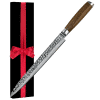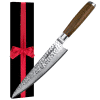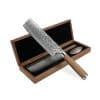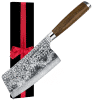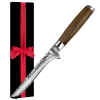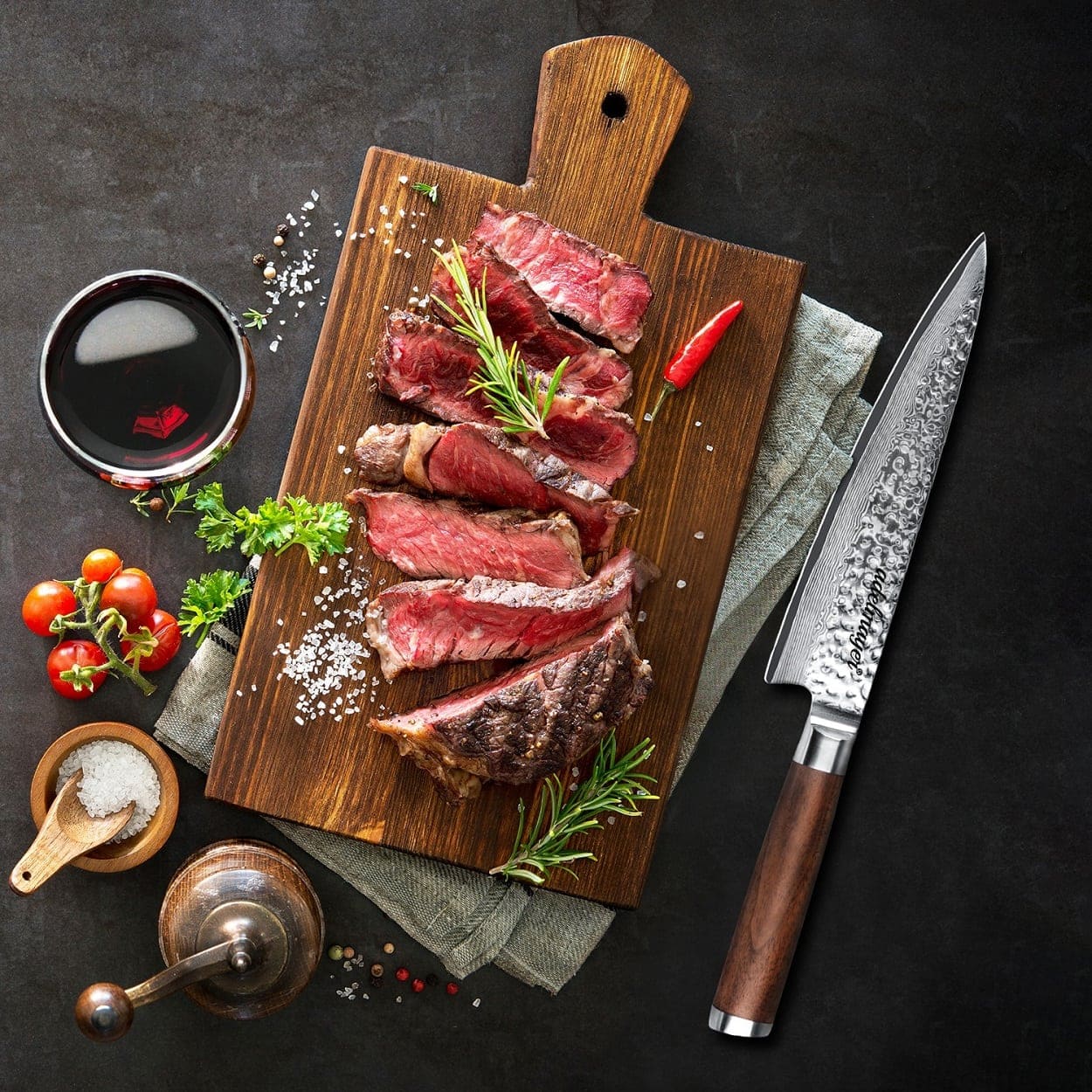
Presentation of the damascus knife
Nowadays there is a great variety of different knives. These differ in many ways. For example, the length of the blade, the way they are sharpened, the shape of the handle or the shape of the blade. For different work should always be the right knife. In this article, however, we want to focus entirely on the special damascus knife. Learn what makes a damascus knife special, how it is made and what should be paid attention to when buying everything to really get a particularly good quality. Last but not least, interested parties can order one of our high-quality damascus knives online.
What is a damascus knife?
Knives are among the most important utensils in our everyday lives. Day after day, most people use the knives already at breakfast, because breads, sausages and other foods must eventually be cut. However, the damascus knife is a very special model among knives. This is a variation with a very characteristic pattern on the blade. Especially in recent years, the popularity of damascus knives has increased enormously, so that not only the professional chef is happy about a high-quality damascus knife. So also in the hobby kitchen as well as at home many users enjoy this traditional and reliable knife.
However, the damascus knives or the damascus blades have long been used not only in the kitchen. They are suitable for many different uses. For example, when hunting or fishing. Also when camping or in the garden. Furthermore, the different models are also popular with collectors. So not only the pure kitchen knife, but at the same time also a tool or but a companion for different projects.
Unlike many other knives, the damascus knife is characterized by several layers of steel. It is therefore very costly to manufacture, but thus also has a much more stable blade, which, however, is just as elastic.
The damascus knife itself is perceived as high quality and expensive. This is a rather traditional knife, which is produced with a very high manufacturing effort. In contrast to many other knives, quite a lot of manual work is required here, which of course also results in a comparatively high sales price. Nowadays, however, most knives are manufactured industrially, so that these are of course very different from the traditional damascus knife.
Of course, many interested parties now certainly ask themselves whether the industrially produced damascus knives are real damascus knives at all. Here the answer is quite easy to find. Yes, these are also genuine damascus knives. However, it is often the case that some aspects are missing in an industrially produced knife, such as the unique character that occurs with manual work or the exoticism that is so appreciated by many knife fans. Also, the variety or but the value are not quite as present here as it is the case with a handmade model.
The variety of a damascus knives
There are many different types of damascus knives. Also the pattern formations of the damascus steel offer almost unlimited possibilities and variations of unique blades. Thus, there is a high number of different influencing factors that affect the respective appearance of the material and always make it something special. In the production of a traditionally manufactured blade, these certain influencing factors are therefore not always 100 percent the same. This in turn leads to a large variety of different damask knife blades. Of course, not all users care about the uniqueness of the knife blade. However, if you look at it from the historical point of view, the individuality of a damascus knife blade is responsible for its popular reputation, for the fame of the damascus knife and for the long-lasting fascination of this special type of knife.
The exoticism of the damascus knives
Often the terms damask or damask steel as well as damascus steel are associated with a saber-wielding warrior or with the city of Damascus. Furthermore, the well-known fairy tale 1001 Nights also has a special connection with this term. These common clichés are thereby supported by today’s media, which of course continues to emphasize the alleged connection of the terms to different things and does not let them be forgotten.
However, these particularly creative connections often have nothing to do with the actual historical development or the geographical distribution. The steel and its distinctive pattern create this special exoticism, because it is simply completely different from other knives.
The damascus knife and its unique character
The damascus knives, which are made of a real handmade damascus steel, are also often called “living” knives. This is due to the fact that really every damascus knife looks different. Like an own handwriting in the structure the kind of the treatment forms with it the special patterns from the damascus knife. The organic patterns are supported by the irregularities and give each knife an entirely new and therefore distinctive character.
In the industrially produced damascus knives, the pattern is of course quite different and always uniform. This is mainly due to the standardized manufacturing processes, which are carried out by machine and thus always run the same. Thus, as already mentioned, the special unique character is lost and also the selection of different patterns is by far not as large. Nevertheless, the industrially produced damascus knives also convince with their unique quality and the high comfort of use.
The quality of the damascus knives
The blades, which were made of Damascus steel, were at that time alone technically very superior. This was due to the fact that the extraction of steel in a high quality and uniform grade was very costly until the time of industrialization. For this reason, even the blades of ordinary soldiers were unfortunately made of average or even very inferior material. A clear disadvantage, as is now known.
The blades made of Damascus steel, on the other hand, were often very elaborate individual pieces, which were therefore at that time primarily intended only for the nobility. They were also mostly produced by only very good blacksmiths, who also mastered the aspects that were crucial for the quality of these blades. For example, geometry, heat treatment and choice of materials. Furthermore, care was taken to ensure that only the best available steels were used for the manufacture of these elaborate blades and high-quality knives.
This advantage is no longer given today. However, the skill of the blacksmith is still very important when it comes to the final quality of the knife blade.
The characteristics of damascus knives
Damascus knives are of course not for nothing very well known and so popular. They stand for quality, for sharpness and for elegance at the same time. The easy handling as well as the optimal handling are further aspects, which differentiates this knife from others. In addition, the beautiful grain on the blade of the damascus knives, which also make purely visually of course quite something and should therefore not be forgotten.
The advantages and disadvantages of damascus knives
Of course, as with other types of knives, the damascus knife does not only have its advantages, and we do not want to deprive our readers of the disadvantages. The relatively high price is of course a very important aspect for many interested parties and often acts as a deterrent. However, we had already explained here how this comes about. As with many other products from different areas, however, the quality is often somewhat more expensive than cheap products, but the quality here is also far better. Furthermore, damascus knives are usually not dishwasher safe and also not stainless. After use, it is therefore advisable that these are washed off directly and dried, which is not a big expenditure of time. So the disadvantages are definitely within limits.
So let’s move on to the advantages of damascus knives, which should be more interesting. For example, the fact that the knife stays nice and sharp for a long time, so it does not need to be re-sharpened so often. In addition, the damascus knives have a high quality of workmanship. Damascus knives also impress with their durability, so users can enjoy these knives much longer than other models because they are more robust. In addition, the typical damascus knife has a blade that is very strong and flexible at the same time. Advantages that therefore justify the slightly higher price and make the damascus knife one of the most popular types of knives.
How is a damascus knife made?
The production of a damascus knife is quite a complex task. In order for the damascus knife to be successfully produced, many different factors play an important role. As is the case in many other areas, there are several ways to achieve the goal of manufacturing. However, we wanted to briefly summarize the production, as it plays an important role in the history and value of damascus knives.
The Damascus steel or Damascus steel is primarily a special workpiece. This was fire-welded from different steels with different alloys, the result of which is also known as “welded composite steel”. For this processing, as a rule, both the very hard and stable steels and softer and tougher steels are used. Before going on to further processing, these are heated at more than 1200 degrees Celsius. Subsequently, the steel is now folded and then forged. This particular process must now be repeated several times, until finally the desired number of steel layers is present. Then these layers are formed into a solid and particularly stable blade. With each folding, the number of layers is doubled, of course, which means that layers of 100 and more are quickly formed. In the case of traditionally forged damascus knives, manufacturers often achieve over 300 layers per blade.
This special type of forging technique creates the special patterns on the damask knife blade, which are created when it finally goes into an acid bath again for hardening and it is then thoroughly polished again.
Are there different types of damascus knives?
There are two very different types of damascus knives, which we would like to introduce in the following.
Wild Damascus
Probably the biggest difference between the individual models is the steel used to make damascus knives. The wild Damascus is particularly popular. Here one uses the hard and soft steel layers, which we had already described. These are now superimposed and fire-welded. The “wild” and irregular damascus, which makes each knife a real unicum, is created because these knives are pure and genuine handmade. Each damascus knife from this manufacturing process is clearly different from the industrial damascus knives, because they all have a special and individual touch. Of course, this also has its price, because the knives like to cost four figures.
Industrial core steel
Of course, 1000 euros and more are simply way too much for a knife for most people. But even here there are high-quality alternatives. We are talking about a damascus knife made from industrial damascus. Here, a core steel is used, which is encased by a few more layers of steel, whereby these are joined together in the respective manufacturing process. Of course, the industrially produced damascus knives also fulfill their purpose and inspire with various works in the kitchen all along the line, but they differ, as mentioned, from the traditional damascus knives.
Buying damascus knives – what to look for?
As already mentioned, the traditional damascus knives are products that are somewhat more expensive to buy than the normal knives. Who wants to buy a damascus knife, should always make sure that this meets some criteria and of course also meets their own needs. We have filtered out some criteria that are particularly important when buying a damascus knife.
The damascus knife size
A particularly important criterion is the size of the damascus knife, which, however, depends individually on the future use. The blade lengths of damascus knives often vary greatly from knife to knife, so you really have to see what comes into question and what does not. If you are only looking for a damascus knife for everyday use, you can get by very well with a blade length of 17 – 20 cm. Furthermore, it should be noted here that especially women with small hands could quickly get problems with knives that are too large. Thus, damascus knives with a 21 cm blade may be a bit heavy in the hand in this case. As a result, the comfort of use would suffer, because cutting with the damascus knife would be so heavier. No wonder, because you automatically apply a lot of force both for cutting and already for holding the knife.
The handling itself is also very important when buying a new knife. And this is where the knife handle comes into play. It is best if the knife handle is ergonomically shaped so that it fits perfectly in the hand. The handle material also plays an enormously important role, although of course tastes differ widely here. Some prefer the handle to be made of real wood, while others would like to have synthetic resin or other materials. Depending on which handle material is finally chosen, the care is also different. However, we will go into the care in more detail.
The number of layers plays a much more important role in a damascus knife than it does in other types of knives. For this reason, it is very important that the number of layers when buying a knife is in no case less than 30 layers. The more, the better it is.
Where to buy the damascus knife?
If you are planning to buy a damascus knife, you should of course research exactly where you can find suitable knives. Furthermore, you should look more closely in advance and find out as much as possible about the individual products. Of course, you now ask yourself whether you should buy the damascus knife online or a specialty store is a better alternative. Both have their own advantages and disadvantages.
So you have the advantage in a specialty store, of course, that you can take the knife in your hand to get a first impression and a feel for the damascus knife. This is not possible when buying on the Internet, although you can also send the knife back if you don’t like it. Of course, the buyer in a store can also help directly with questions, although online retailers are often reachable by mail or phone.
If you want to buy the damascus knife online, you often get a much larger selection of different products, which can now also be compared with each other. So most have nowadays because of the family or the stressful work no time to visit several stores. In addition, it is only in larger cities the case that really specialized stores are on site. Ordering on the Internet works 24 hours a day, seven days a week. In addition, the damascus knife is then conveniently delivered to the desired address, usually within a few days.
Also in our online store we offer customers not only a good overview and plenty of information about the damascus knife itself, but also ensure fast shipping of the goods. In addition, by the way, on the Internet you can rely on testimonials from people who have been using the respective knives for a while.
Damascus knife care – what to consider?
It is clear that a damascus knife is a particularly high-quality knife that should be cared for accordingly. However, in order for the knife to remain nice and sharp, special knife care is necessary. One of the most important points is the fact that these high-quality knives should never be put in the dishwasher. The enormous heat exposure can change the structure of the steel and the chemicals used there are often far too aggressive, so that damage to the steel itself is not uncommon. If the handle is made of wood, for example, this can also swell. This can also happen, by the way, if the knife is simply lying in the rinse water. It is also not uncommon for rust to quickly form on the blade.
It is best to wash the damascus knife by hand directly after use, so that the remains of the food can not even settle. Lukewarm water is often sufficient. However, a cloth with a rough surface should not be used. A microfiber cloth is therefore best suited and ensures that the blade is not worn. After the blade is now completely clean, it must be dried directly. It is important to make sure that the sharp side of the blade never points in the direction of the user’s own hand, otherwise there is a great risk of injury.
If the knife has not been used for a long time, it is advisable to rub it with a little camellia oil. Here, too, a few drops are added to the microfiber cloth and then rubbed into the blade and the knife handle. In between, the rubbing with the oil helps to keep it nice and supple and rust-free.
Care also includes the proper storage of damascus knives. In no case should this lie together with other knives in a drawer. Contact with other knives, metals and steels can dull the blade more quickly and cause further damage. For this reason, it is always advisable to use a magnetic rail or to use a knife block. Our damascus knives, for example, are delivered in a beautiful box, which is also ideal for storage.
Important care instructions in overview:
- Do not put in the dishwasher
- Do not clean with chemicals
- Clean with lukewarm water only
- Do not use a cloth with a rough surface
- Use microfiber cloth when cleaning
- Dry thoroughly immediately after cleaning
- Regular rubbing with camellia oil
- Never store in the drawer with other steel products or metals
- Storage best in knife block, magnetic rail or special knife box
How to sharpen the damascus knife? – this is how
Of course, the Damascus knife also needs to be sharpened from time to time. However, this is not as easy as one might think. It is therefore important to find out more about this in advance in order not to damage the blade unnecessarily. So it is not uncommon for the special Damascus blade to be sharpened in the same way as a conventional blade, which can, however, lead to major problems. We have prepared a step-by-step guide that is especially suited to the damascus knife. For more information on knife sharpening, you can read our article “Knife sharpening made easy“.
Damascus knife sharpening step 1:
Before sharpening the knife, the whetstone must first lie in the water. It is best if the whetstone can even lie in the water for 15 – 30 minutes. Clear and lukewarm water is best suited for this. This has the effect that not too much material is removed from the blade during grinding. In addition, the grinding is easier overall, because you do not have to use so much force. As soon as no more bubbles rise in the water from the whetstone, it is sufficiently watered and can be removed. To avoid dripping all over the base, it is not a bad idea to let the stone drip off a little.
Damascus knife sharpening step 2:
The second step involves sharpening the blade. It is important to know that here in any case should not use a sharpening steel. Of course, sharpening with this accessory is particularly well known. However, it is a pure torture especially for sharpening from the damascus knife, where the blade is also roughened. Unlike the normal knife, the damask blade does not have a smooth surface. It can rather be compared to a large razor blade, so it is quite clear that sharpening it with a sharpening steel would only damage it.
The first step is to place the knife on the whetstone. At the height of your own thumb, it is now lifted at an angle, creating the optimum angle for grinding. The knife is now pulled from the tip in an arcing motion to the very back and then back again. It is important to make sure that the entire length of the blade is sharpened. It is often observed, especially with beginners, that they do not perform the sharpening movement correctly and that the blade is not completely sharpened. With the forward movement, a little more pressure is used, while with the backward movement, a little pressure must be taken out. Then the reverse side is machined. During sharpening, a little water should be dribbled onto the whetstone every now and then.
Damascus knife sharpening step 3:
Now it is time for resharpening and polishing. The procedure is the same as for grinding, but a specific polishing stone is used for this. The polishing stone should have a grit of 3000 or more, although there are also models with a grit of over 8000. With such a very fine grit, no material is removed from the knife itself. So only the surface of the cutting edge is smoothed, as well as the rest of the blade. Here, too, work is done in an arc movement from front to back.
Damascus knife sharpening step 4:
The fourth step lies in the cleaning. After you are done with the grinding itself, the knife must of course be cleaned so that all residues of the removed material are removed. Residue from the grinding paste must also be removed, of course. For the cleaning itself, the damascus knife must simply be held under lukewarm water. In doing so, the blade and handle are thoroughly washed. Afterwards, the knife is dried thoroughly.
Damascus knife sharpening step 5:
Of course, after grinding and polishing, you should take another look to see if the elaborate grinding process was successful. For this purpose, the damascus knife must now be tested. Among other things, the tomato test is the best way to do this. For this, a few days old tomato is used, which is therefore already somewhat softer. This must now be cut into thin slices. Without any pressure or effort. If the tomato is now cut through without any problems, the damascus knife is nice and sharp again and can now be put back into the knife sheath or box and stored there.
Damascus knives from our store
If you are looking for a high-quality damascus knife, you should take a closer look at our online store. We have spent a lot of time in the production and development and designed a damascus knife that always keeps its promise and can also convince in terms of design and ease of use. In addition to the damascus knives, we also offer our customers very informative eBooks on various topics.
If you have any questions, suggestions or requests, we will of course be happy to assist our customers.

